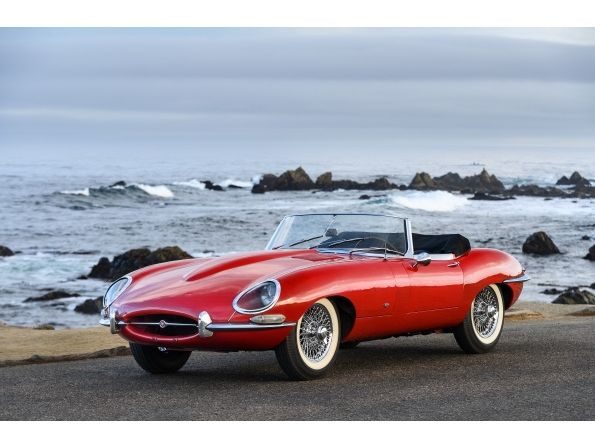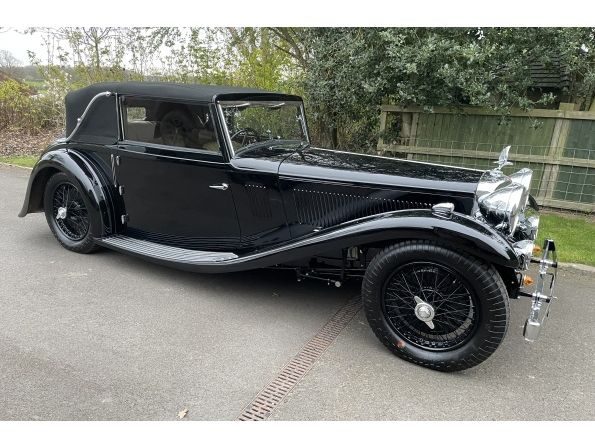Categories more
- Adventures (17)
- Arts / Collectables (15)
- Automotive (37)
- Aviation (11)
- Bath, Body, & Health (77)
- Children (6)
- Cigars / Spirits (32)
- Cuisine (16)
- Design/Architecture (22)
- Electronics (13)
- Entertainment (4)
- Event Planning (5)
- Fashion (46)
- Finance (9)
- Gifts / Misc (6)
- Home Decor (45)
- Jewelry (41)
- Pets (3)
- Philanthropy (1)
- Real Estate (16)
- Services (23)
- Sports / Golf (14)
- Vacation / Travel (60)
- Watches / Pens (15)
- Wines / Vines (24)
- Yachting / Boating (17)
Published
08/20/2023 by Salon PrivéIf proof were needed of Britain’s pre-eminence in the creation of some of the world’s most elegant and successful drophead automobiles, Salon Privé has gathered two of the most compelling pieces of evidence at its Blenheim Palace Concours this month.
The remarkable pair, represented by Alvis and Jaguar, illustrates the British motor industry’s leadership in design, engineering and manufacturing for quality open-topped cars in the pre- and post-war years, and is set to be a popular draw throughout the event.
1934 Alvis Speed 20 SB Three-Position Drophead Coupé by Vanden Plas
Described as the epitome of pre-war sporting elegance, the Alvis Speed 20 combined exquisite build quality, luxury and technical innovation in a prestigious package that would have been the envy of many a Lagonda or Bentley owner in the day.
Produced between 1932 and 1936 in four iterations, categorised from ‘SA’ to ‘SD’, the Speed 20 was powered by an inline ‘six’ engine, derived from Alvis’s late-vintage Silver Eagle model. Generating 87bhp at 4000rpm, the unit could propel the large car to a top speed of 90mph, making it one of the fastest vehicles available in the 1930s. The ’20 was also incredibly advanced versus other pre-war rivals, and was equipped as standard with independent front suspension, an all-synchromesh gearbox and servo-assisted brakes.
And Salon Privé’s example, a 1934 second-series SB drophead coupé, is something of a rarity. Of the 1,165 Speed 20s produced, a majority were rakish, close-coupled saloons, mainly bodied by Charlesworth or Vanden Plas. But chassis 11857 is one of only 36 four-seat tourers built by Vanden Plas on an SB chassis.
Originally supplied by Charles Follett of Mayfair to Francis Fernau, a lawyer who later became a clerk to the Privy Council, the ’20 was first registered on July 31st, 1934. During the next 31 years, the car passed through just three more owners, before being purchased by David Leslie Dartnell of Huntley, Gloucestershire in 1965. By then in a non-running state, Dartnell recommissioned the car and put it through an MOT test to make it roadworthy, eventually keeping the ‘20 for the next 49 years. It was then sold by him at auction in 2014 to the current owner, who commissioned a comprehensive preservation/restoration by Steven Hall of Bridgenorth, which took six years to complete. Hall’s brief was to preserve as much of the car’s originality as possible, to the extent that he used ex-Alvis craftsmen to undertake much of the work, using re-conditioned original parts wherever possible. The end result is a credit to Hall and his team and will be a stand-out attraction at Blenheim later this month.
1961 Jaguar E-Type Roadster
There’s very little that hasn’t been written about the Jaguar E-Type over the years, but Salon Privé’s car is particularly special, with a remarkable back-story.
Launched in 1961 to great fanfare, the E-Type was originally conceived as a competition car and was, in all major design respects, a direct descendent of Jaguar’s D-Type racer, with one major difference: it was a completely refined, docile and roadworthy machine, which was also unbelievably cheap to buy, and used very few sophisticated special parts.
Chassis 875026 was one of the first E-Types to reach customer hands in 1961, when it was delivered to legendary American racer, Briggs Cunningham, along with two other new E-types. All three cars were left-hand-drive, but British-registered, so that Briggs and his team could drive them in Europe during the race season; in fact, Cunningham’s E-Type trio would likely have been the first such models to attend that year’s Le Mans 24 Hours, where he and his team were campaigning Maseratis in the race.
The E-Types were then exported to the United States, where one of Cunningham’s team drivers, Walt Hansgen, used chassis 875026 as his personal road car, and as a demonstrator at his New Jersey Jaguar dealership. Later that year, or early in 1962, the car was sold and up to 1973 passed through two more owners, until it was purchased by Jaguar authority, Tom Haddock, having accrued 53,523 miles. Still in remarkably original condition, Haddock hardly drove the car (he covered just 752 miles in the next 46 years) but used it as a reference for his respected book, Jaguar E-Type Six Cylinder Originality Guide. Haddock sold the car in 2019, after which it was recommissioned, but using original parts: today, only the tyres and fluids are non-period.
Salon Privé’s David Bagley is delighted to have such significant British dropheads at this month’s concours: “British drophead cars were revered across the world, and the two we have at Salon Privé are splendid examples of our industry’s design and engineering brilliance either side of the war. That the E-Type comes with such remarkable provenance, yet is almost completely original, is something we should all applaud.”
Salon Privé Week 2023
- 30 August – Salon Privé Concours presented by Aviva.
- 31 August – Salon Privé Concours presented by Aviva.
- 1 September – Salon Privé Ladies’ Day presented by Boodles.
- 2 September – Salon Privé Supercar Saturday presented by Lockton.
- Tickets can be purchased via the website: www.salonpriveconcours.com
Charity Partner
Salon Privé is proud to have Rainbow Trust Children’s Charity as its charity partner once again. The organisation provides emotional and practical support to families who have a child with a life-threatening or terminal illness, and thanks to the generation donations of guests and Concours entrants, the event has so far raised in excess of £1.1 million for these great causes.
















